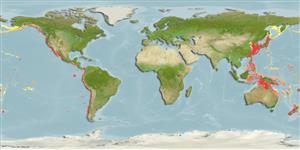>
Scombriformes (Mackerels) >
Scombridae (Mackerels, tunas, bonitos) > Scombrinae
Etymology: Scomber: Greek, skombros = tunny or mackerel, 1623 (Ref. 45335); japonicus: Named after Japan, its type locality (Ref. 6885).
Environment: milieu / climate zone / depth range / distribution range
بوم شناسي
دريايي; اقیانوس رو (Ref. 51243); تغييرات عمق 0 - 300 m (Ref. 168), usually 50 - 200 m (Ref. 35185). Subtropical; 10°C - 27°C (Ref. 35185); 60°N - 48°S, 116°E - 70°W
Indo-Pacific: anti-tropical, absent from the Indian Ocean except for South Africa, KZN to Western Cape (58304).
Reports from Atlantic incl. Mediterranean are Scomber colias, and from Red Sea and northern Indian Ocean are Scomber australasicus (Ref. 27328).
Length at first maturity / Size / Weight / سن
Maturity: Lm 26.1 range ? - ? cm
Max length : 64.0 cm TL جنس نر / بدون خواص جنسي; (Ref. 9015); common length : 30.0 cm FL جنس نر / بدون خواص جنسي; (Ref. 168); بيشينه وزن گزارش شده: 2.9 kg (Ref. 26550); بيشينه سن گزارش شده: 18 سال ها (Ref. 35185)
خارهاي باله پشتي (کل): 9 - 11; شعاع نرم باله پشتي (کل): 112; خارهاي باله مخرجي 1; شعاع نرم باله مخرجي: 12 - 14; مهره ها: 31. Interpelvic process small and single. No well developed corselet. Swim bladder present. First haemal spine posterior to first interneural process; 12 to 15 interneural bones under first dorsal fin. Anal fin spine conspicuous, clearly separated from anal rays but joined to them by a membrane. Back with narrow stripes which zigzag and undulate. Belly unmarked (Pacific population) or with wavy lines (Atlantic pop.) (Ref. 168). Caudal peduncle with 5 finlets on the upper and lower edge. Distance between dorsal fins shorter than or equal to the first dorsal fin base (Ref. 35388).
A coastal pelagic species, to a lesser extent epipelagic to mesopelagic over the continental slope (Ref. 168). Schooling by size is well developed and initiates at approximately 3 cm (Ref. 168); may also form schools with Sarda chiliensis, Trachurus symmetricus and Sardinops sagax (Ref. 9340). Adults stay near the bottom during the day; go up to the open water at night, (Ref. 5377) where they feed on copepods and other crustaceans, fishes and squids (Ref. 168). They spawn in batches (Ref. 51846). Eggs and larvae are pelagic (Ref. 6769). In Asian waters, they move to deeper water and remain inactive during the winter season (Ref. 4576). Commercially cultured in Japan. Marketed fresh, frozen, smoked, salted and occasionally canned (Ref. 9684). Eaten fried, broiled and baked (Ref. 9988). Used in Chinese medicine (Ref. 12166).
Spawning most often occurs at water temperatures of 15° to 20°C. Spawn in several batches with 250 to 300 eggs per g of fish with the total number of eggs per female ranging from 100,000 to 400,000.
Collette, B.B. and C.E. Nauen, 1983. FAO Species Catalogue. Vol. 2. Scombrids of the world. An annotated and illustrated catalogue of tunas, mackerels, bonitos and related species known to date. Rome: FAO. FAO Fish. Synop. 125(2):137 p. (Ref. 168)
وضعيت در فهرست قرمز IUCN (Ref. 130435)
خطر برای انسان ها
Harmless
استفاده انسانی
ماهي گيري – شيلات: با ارزش تجاري بالا; آبزي پروري: تجاري; ماهي ها ي سرگرم كننده: بله; طعمه: usually
ابزارها
گزارش های ويژه
بارگيری XML
منابع اينترنتي
Estimates based on models
Preferred temperature (Ref.
123201): 9.3 - 27.7, mean 20.7 °C (based on 1526 cells).
Phylogenetic diversity index (Ref.
82804): PD
50 = 0.5625 [Uniqueness, from 0.5 = low to 2.0 = high].
Bayesian length-weight: a=0.00741 (0.00662 - 0.00830), b=3.05 (3.02 - 3.08), in cm total length, based on LWR estimates for this species (Ref.
93245).
Trophic level (Ref.
69278): 3.4 ±0.1 se; based on diet studies.
Generation time: 3.6 (3.1 - 5.0) years. Estimated as median ln(3)/K based on 24
growth studies.
جهندگی (Ref.
120179): متوسط, كمينه زمان لازم براي دو برابر شدن جمعيت 4/1 – 4/4 سال (K=0.12-0.22; tm=2-3; tmax=18).
Prior r = 0.48, 95% CL = 0.32 - 0.73, Based on 3 stock assessments.
Fishing Vulnerability (Ref.
59153): Low to moderate vulnerability (31 of 100).
Climate Vulnerability (Ref.
125649): Low vulnerability (24 of 100).
Nutrients (Ref.
124155): Calcium = 48.8 [16.2, 118.3] mg/100g; Iron = 2.18 [0.83, 5.26] mg/100g; Protein = 20.9 [19.8, 21.8] %; Omega3 = 0.358 [0.247, 0.525] g/100g; Selenium = 98.1 [37.9, 229.9] μg/100g; VitaminA = 13.7 [3.5, 60.5] μg/100g; Zinc = 0.846 [0.514, 1.358] mg/100g (wet weight); based on
nutrient studies.
